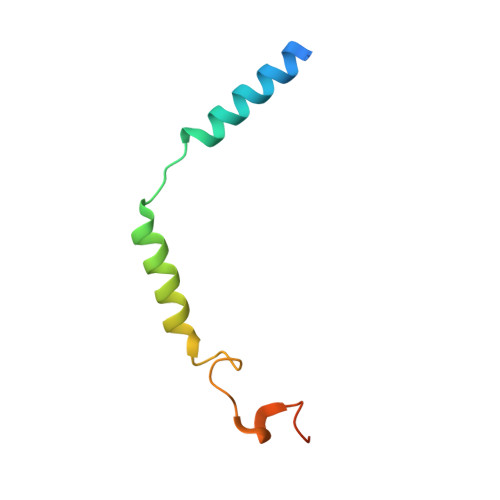A New Paroxetine-Based GRK2 Inhibitor Reduces Internalization of themu-Opioid Receptor.
Bouley, R.A., Weinberg, Z.Y., Waldschmidt, H.V., Yen, Y.C., Larsen, S.D., Puthenveedu, M.A., Tesmer, J.J.G.(2020) Mol Pharmacol 97: 392-401
- PubMed: 32234810
- DOI: https://doi.org/10.1124/mol.119.118661
- Primary Citation of Related Structures:
6U7C - PubMed Abstract:
G protein-coupled receptor (GPCR) kinases (GRKs) play a key role in terminating signals initiated by agonist-bound GPCRs. However, chronic stimulation of GPCRs, such as that which occurs during heart failure, leads to the overexpression of GRKs and maladaptive downregulation of GPCRs on the cell surface. We previously reported the discovery of potent and selective families of GRK inhibitors based on either the paroxetine or GSK180736A scaffold. A new inhibitor, CCG258747 , which is based on paroxetine, demonstrates increased potency against the GRK2 subfamily and favorable pharmacokinetic parameters in mice. CCG258747 and the closely related compound CCG258208 also showed high selectivity for the GRK2 subfamily in a kinome panel of 104 kinases. We developed a cell-based assay to screen the ability of CCG258747 and 10 other inhibitors with different GRK subfamily selectivities and with either the paroxetine or GSK180736A scaffold to block internalization of the μ -opioid receptor (MOR). CCG258747 showed the best efficacy in blocking MOR internalization among the compounds tested. Furthermore, we show that compounds based on paroxetine had much better cell permeability than those based on GSK180736A , which explains why GSK180736A -based inhibitors, although being potent in vitro, do not always show efficacy in cell-based assays. This study validates the paroxetine scaffold as the most effective for GRK inhibition in living cells, confirming that GRK2 predominantly drives internalization of MOR in the cell lines we tested and underscores the utility of high-resolution cell-based assays for assessment of compound efficacy. SIGNIFICANCE STATEMENT: G protein-coupled receptor kinases (GRKs) are attractive targets for developing therapeutics for heart failure. We have synthesized a new GRK2 subfamily-selective inhibitor, CCG258747 , which has nanomolar potency against GRK2 and excellent selectivity over other kinases. A live-cell receptor internalization assay was used to test the ability of GRK2 inhibitors to impart efficacy on a GRK-dependent process in cells. Our data indicate that CCG258747 blocked the internalization of the μ -opioid receptor most efficaciously because it has the ability to cross cell membranes.
Organizational Affiliation:
Life Sciences Institute (R.A.B., H.V.W.), Departments of Medicinal Chemistry (H.V.W., S.D.L.) and Pharmacology (R.A.B., Z.Y.W., M.A.P.), and Vahlteich Medicinal Chemistry Core, College of Pharmacy (H.V.W., S.D.L.), University of Michigan, Ann Arbor, Michigan; and Departments of Biological Sciences and of Medicinal Chemistry and Molecular Pharmacology (Y.-C.Y., J.J.G.T.), Purdue University, West Lafayette, Indiana.

















